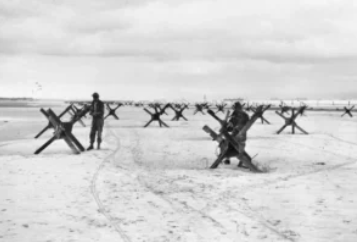ON D-DAY, six Royal Marine and four Royal Navy LCOCUs, Landing Craft Obstruction Clearance Units [LCOCUs pronounced Lock-yews] each comprising an officer and 11 men, were deployed from LCAs from H-Hour.
LCOCUs (3, 4 RN), 9 and 10 were assigned to Gold Beach (Force G), 7 and 8 to Sword (Force S), and (1, 5 RN), 11 and 12 to Juno (Force J).
Operating from inflatable boats, they were responsible for clearing obstructions in depths between 3m and 1.4m, while the Royal Engineers had the job of clearing shallower areas and the beach itself.
They were all intended to clear paths through beach obstacles, but owing to the conditions of the tide and dangers from incoming craft the men were unable to use their shallow water diving gear, but nevertheless cleared obstacles.
Despite coming under artillery and mortar fire and being shot at, the LCOCUs succeeded in clearing thousand-yard-wide gaps in the offshore defences before helping the Royal Engineers with their tasks. By the end of the day, they had cleared 2500 obstacles at the cost of Acting Leading Seaman Allister Austin (LCOCU 3) being killed and several other divers wounded, some seriously.
For “gallantry, skill, determination and undaunted devotion to duty during the initial landings on the coast of Normandy”, Lieutenants Robert Billington, Harold Hargreaves and John Taylor of the Royal Naval Volunteer Reserve were awarded the Distinguished Service Cross. Lt David Cogger RM was awarded the Military Cross.
Royal Marine Sergeants Keith Briggs and Peter Jones, Petty Officers Sydney Eagles and George Lock, Leading Seaman Frank Livingstone and Marine Eric Deans were awarded the Distinguished Service Medal.
Related Royal Marines 'Dits'




Comentários